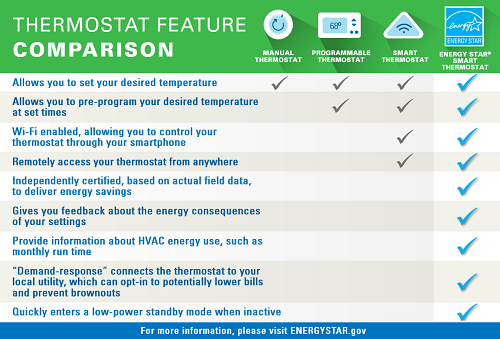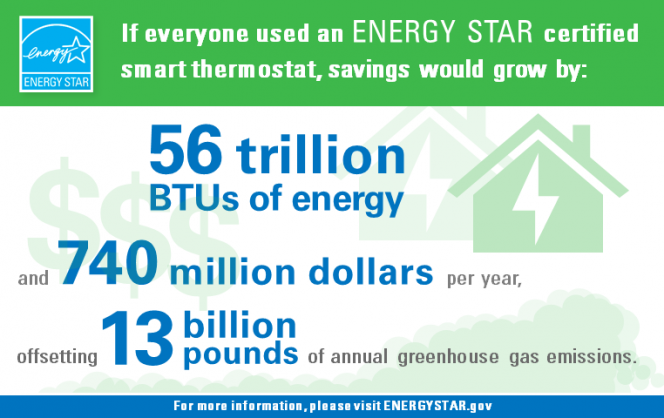How to Choose a Smart Thermostat
If you have a manual or programmable thermostat and are considering an upgrade, there are plenty of reasons you should choose a “smart” thermostat for your home. Here’s what you need to know to make the right choice for you!
What is a Smart Thermostat?
A “smart” thermostat is a Wi-Fi enabled thermostat that allows you to control your home’s heating and cooling temperature settings from your “smart” devices (phone, tablet, or computer). Smart thermostats offer greater convenience, energy savings, and control than manual or programmable thermostats.
Why Should You Choose an ENERGY STAR Certified Smart Thermostat?
While all smart thermostats allow you to set your desired temperature at pre-programmed times from anywhere on your smart device, only ENERGY STAR certified smart thermostats offer all of that, plus energy savings, cost savings, and environmental protection.

Energy Savings
A smart thermostat alone does not use a lot of energy. However, it controls devices that use a lot of energy through heating and cooling. To meet ENERGY STAR’s requirements for smart thermostat energy savings, manufacturers must show how their model reduces the HVAC system’s use in different climates across the country.
Only smart thermostats that earn the ENERGY STAR label have been independently certified, based on actual field data, to deliver energy savings. Additionally, ENERGY STAR certified smart thermostats are required to be able to enter a low-power standby mode when inactive, which saves even more energy.
Cost Savings
The average American household spends more than $900 each year on heating and cooling costs. Controlling your temperature settings with a smart thermostat will help you save money while staying comfortable in your home, year-round. If you live in an area with extreme hot or cold temperatures, your HVAC system will likely get more use and coupled with a smart thermostat, you could save more on your energy bills. Homes with high heating and cooling bills could save up to $100 a year.
Save More with Rebates and Other Offers
-
Rebates: At the point of purchase, many utilities offer rebates to reduce the cost of an ENERGY STAR certified smart thermostat. Enter your zip code into the ENERGY STAR Rebate Finder to see if your utility offers rebates on certain models.
-
Demand-response/Time of use rates: ENERGY STAR certified smart thermostats are designed to be compatible with electricity management programs offered by local utilities. Program availability is dependent on your service territory, but they are put in place to slightly curtail energy use at high demand times. Less energy use at peak demand = less money spent on bills. Check with your utility provider for more information.
Saving Energy Protects the Environment
In addition to saving money, ENERGY STAR certified smart thermostats help reduce greenhouse gas emissions. If everyone used an ENERGY STAR certified smart thermostat, our annual savings would grow to 56 trillion BTUs of energy and $740 million per year, while offsetting 13 billion pounds of greenhouse gas emissions each year.

What to Consider When Purchasing a Smart Thermostat
Four main things to consider before purchasing a smart thermostat are Compatibility, Price, Installation and Connectivity.
Compatibility
Make sure the smart thermostat model you choose is compatible with your HVAC system. In fact, due to the variety of models and systems, you may benefit from consulting an expert before you buy. However, here are a couple of easy checks you can do yourself:
HVAC System Type – Your home’s HVAC system will determine your ability to use a smart thermostat. Smart thermostats are compatible with most forced air HVAC systems that were installed after 1975. If you have an oil boiler or furnace, you may need an adapter. If your HVAC system is variable speed, multi-stage, or zoned for different areas of your home, you will likely need a professional to install a thermostat that can handle those systems. Most smart thermostats available in the U.S. market are not compatible with baseboard heating, biofuels, or in-wall heaters. ENERGY STAR certified smart thermostats are compatible with most HVAC systems.
Wires and Voltage - If you remove your old thermostat cover and see thicker wires for line-voltage control, that is an indicator your HVAC system may not be compatible. Most smart thermostats use thin, low voltage wires. Unlike a programmable thermostat that can sustain itself from a battery, smart thermostats require more consistent and reliable power for things like keeping connection to your Wi-Fi network or the touch screen. Most, but not all, smart thermostats function by receiving power through a “C- wire”, or “Common Wire”. This provides a constant power source from your HVAC control board. Not having a C-wire does not necessarily mean you will be unable to have a smart thermostat, but it will likely influence the models and brands that will work for your home or may require an adapter.
Price
Some smart thermostats include more high-end features than others, meaning prices for smart thermostats can vary widely. Models can range anywhere from $50 to $300. Depending on where you live and your utility, there may be an opportunity to get a smart thermostat at a reduced price, either through a discount or rebate.
Depending on your budget, preferences, and rebates available in your area, you should be able to find a model that's right for you.
Installation
Once you've decided on which smart thermostat to buy, based on your homes compatibility and your personal preference for design, features, and price point, it will need to be properly installed before you start to reap the rewards of an ENERGY STAR certified smart thermostat. Depending on your personal comfort level, you may be able to install it yourself or you may recruit the help of a professional.
Find a Professional:
If you need a second opinion on compatibility, or would prefer an expert's help with installation, look for an experienced electrician or HVAC professional. The maker of the smart thermostat you purchased, or your electric utility should also be able to point you in the right direction. Some smart thermostat brands have trained staff available to guide you over the phone.
Connectivity
For best performance, make sure your smart thermostat is reasonably close to the Wi-Fi router to prevent periodic disconnections. If your thermostat is too far from your router, consider a Wi-Fi range extender, which can improve overall connectivity.
Other Features to Consider
Learning capabilities: Learns and adapts to your routine and your temperature preferences and automatically establishes a schedule that adjusts to energy-saving temperatures when you are asleep or away.
Geofencing: With your permission, your smart thermostat may use the app on your phone to detect when you are away or at home. When you leave the house and travel outside of a certain distance, the smart thermostat will lower the temperature (if in heat mode) or raise the temperature (if in cool mode). When you're on your way home, the smart thermostat can automatically adjust your home's temperature to your liking, so you arrive to a comfortable temperature.
Vacation mode: Lets the thermostat know when you will be gone from your home for longer periods of time to manage the temperature, avoiding frozen pipes in the winter and extreme heat in the summer.
Automatic updates: Updates software periodically to ensure it uses the latest algorithms and Energy- saving features available.
Sensors: Helps to manage extreme temperature differences in a home through either temperature or occupancy sensing technology.
Temperature sensors work in single zone homes (meaning you have one HVAC system controlling the whole house) to monitor rooms with differing temperatures due to the lack of insulation, sun exposure, etc. Sensors allow the smart thermostat to adjust the overall temperature to manage hot and cold spots, especially critical in larger homes.
Occupancy sensors work to determine which rooms are the most high- traffic and prioritize managing their temperature, without sacrificing comfort in the rest of the house.
Voice Assistant integration: Some smart thermostats are compatible with popular Voice Assistant programs, meaning you can simply ask the thermostat to turn the temperature up or down a few degrees, among other things.
Music streaming: As smart thermostats begin to have speakers integrated, some offer music streaming. Consider it an extra speaker, built into your wall.
Each smart thermostat uses slightly different features to help homeowners save energy. Do your research and choose the ENERGY STAR certified smart thermostat that’s right for you.
Ready to Shop?
Compare models and find the smart thermostat that’s right for you in ENERGY STAR’s Smart Thermostat Product Finder.
Author


